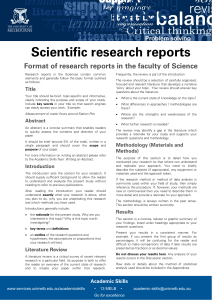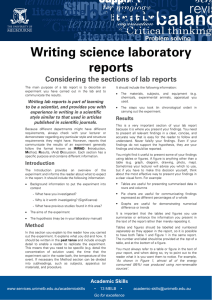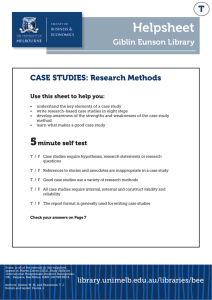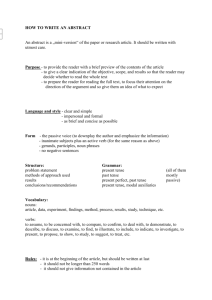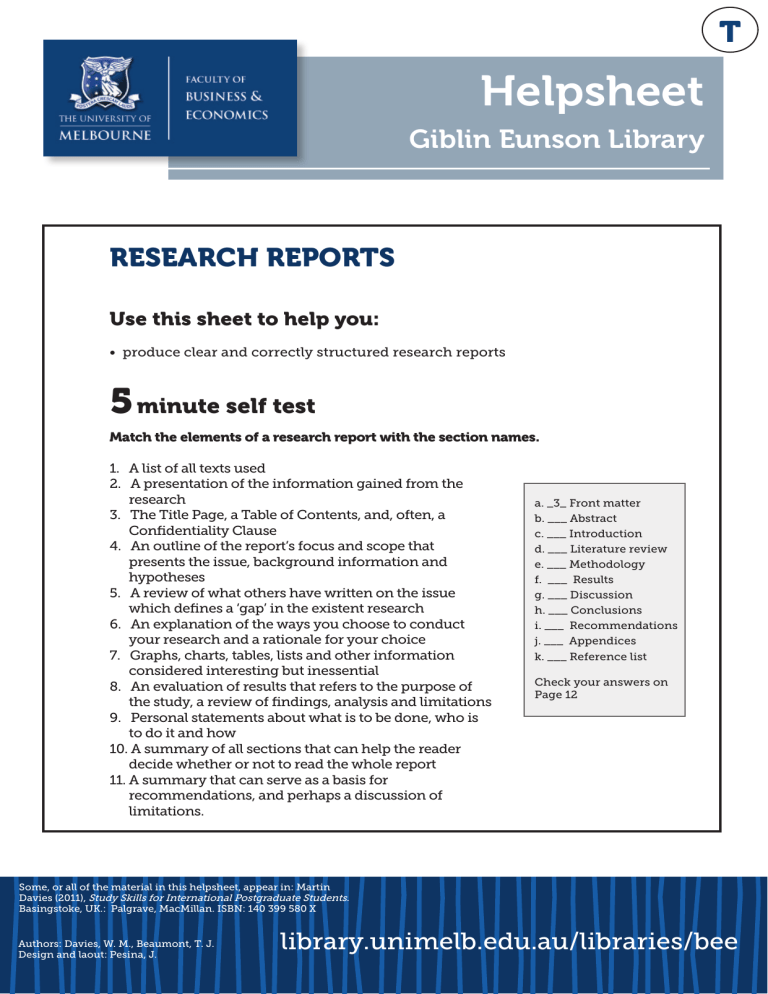
T Helpsheet Giblin Eunson Library RESEARCH REPORTS Use this sheet to help you: • produce clear and correctly structured research reports 5 minute self test Match the elements of a research report with the section names. 1. A list of all texts used 2. A presentation of the information gained from the research 3. The Title Page, a Table of Contents, and, often, a Confidentiality Clause 4. An outline of the report’s focus and scope that presents the issue, background information and hypotheses 5. A review of what others have written on the issue which defines a ‘gap’ in the existent research 6. An explanation of the ways you choose to conduct your research and a rationale for your choice 7. Graphs, charts, tables, lists and other information considered interesting but inessential 8. An evaluation of results that refers to the purpose of the study, a review of findings, analysis and limitations 9. Personal statements about what is to be done, who is to do it and how 10. A summary of all sections that can help the reader decide whether or not to read the whole report 11. A summary that can serve as a basis for recommendations, and perhaps a discussion of limitations. a. _3_ Front matter b. ___ Abstract c. ___ Introduction d. ___ Literature review e. ___ Methodology f. ___ Results g. ___ Discussion h. ___ Conclusions i. ___ Recommendations j. ___ Appendices k. ___ Reference list Check your answers on Page 12 Some, or all of the material in this helpsheet, appear in: Martin Davies (2011), Study Skills for International Postgraduate Students. Basingstoke, UK.: Palgrave, MacMillan. ISBN: 140 399 580 X Authors: Davies, W. M., Beaumont, T. J. Design and laout: Pesina, J. library.unimelb.edu.au/libraries/bee RESEARCH REPORTS T Report, research paper, project or essay? The report format is standard in style although the word “report” is sometimes used ambiguously in the Faculty. It is important to be clear what a particular lecturer means by the word before you begin writing a “report”. Often a lecturer will ask you to write a “report”, but what they mean is write an “argumentative essay”. This use of the word “report” is common in management subjects. (We don’t address the essay format here, see Study and Research Helpsheets: Essay Writing: The Basics and Essay Writing Attitude.) In some subjects such as Accounting, the report format described here is sometimes called a “research paper”, an “experimental report”, “formal report”, or a “formal project”. The name used is less important than the style adopted. Report structure: overview Your lecturer will probably show you what a typical report looks like, and how the sections should be organised. There may be particular requirements in different disciplines. You must follow your lecturer’s requirements exactly. This Helpsheet provides general information only. Reports typically have the following sections: • • • • • • • • • • Front matter (This may include a Confidentiality Clause, Table of Contents, List of Figures, Abbreviations, etc) Abstract (or “Executive Summary”) Introduction and Literature Review (can be separated) [20 percent] Methodology (and sometimes Procedure) (can include a Theoretical Model) [10 percent] Results/Findings (and sometimes Case Study to make the results clear and practical) [25 percent] Discussion/Analysis [25 percent] Conclusions and Limitations of Research [10 percent] Recommendations (can be combined with Conclusion) [10 percent] Appendices Reference List Note that the precise structure of a report will depend of the purpose for which it is intended. The above sections would cover the typical experimental report format. If your report is a business report then the Literature Review and Methodology sections may not need to be included. Page 1 library.unimelb.edu.au/libraries/bee RESEARCH REPORTS T Report structure: details 1. Front matter The Front Matter consists of the title page as well as usually some of the other elements listed below (all on new pages). It is customary to paginate the front matter with Roman numerals (i, ii, iii, iv …) and commence the Introduction, which forms the main text of the report, with Arabic numerals (1, 2, 3 …). The Abstract or Executive Summary can appear before the Table of Contents and is generally not numbered. Title page Apart from the title (what the report is about), the title page should contain the following information: • Author’s name • Person (or body) for whom it is written • Purpose of the report with its limitations (terms of reference) • Date it was requested • Date due Confidentiality clause This is sometimes given if the report describes commercially sensitive material. This may specify a “release date” for the report. Table of contents As reports are generally organised into main sections and sub-sections, the Table of Contents sets out this in detail: 3, 3.1, 3.2, 3.2.1, etc with associated titles. Don’t go crazy with subsections (no more than 3 or 4 levels). If you need more than 4 levels, re-organise your sections so this is avoided. Word has a Table of Contents function which automatically updates titles and pages as needed. It is well worth learning how it works. Lecturers in the CELT can teach you. Example: 3. TRANSPORT 3.1 Rail transport 3.1.1 Advantages of Rail transport 3.1.2 Disadvantages of Rail transport 3.2 Road transport 3.2.1 Advantages of Road transport 8 8 9 10 11 12 List of illustrative contents Sometimes a List of Illustrative Contents is included. It too should be on a separate page and listed in the Table of Contents. Page 2 library.unimelb.edu.au/libraries/bee RESEARCH REPORTS T The list of tables and figures This should be presented clearly, identifying the page number where each table or diagram occurs. Abbreviations Any abbreviations used in the report are outlined on a separate page. 2. Abstract or executive summary This is hard to write and should be written last. The Abstract is meant to summarise all sections of the report, so that the busy professional can get the main ideas just by reading the Abstract. There are generally five stages which mirror the main sections of the report: 1. 2. 3. 4. 5. Background Purpose Methodology Results Conclusions and Recommendations The Abstract can be called a “Synopsis”, “Summary” or “Executive Summary”. Its length depends on the length of the report (however 100-350 words is usual). It is a vital part of the report and will be read by more people that the report itself. It should be specific, giving all the main information and facts in complete sentences in the same order as they occur in the report. It must include conclusions (with their significance and implications) and recommendations (the actions called for). Although the abstract comes first in the report, by necessity it has to be written last—and with great care. (See Study and Research Helpsheet: Abstracts for further details). 3. Introduction The Introduction provides necessary background information. You can outline what is covered in the different sections of the report here and mention the purpose and scope of the report. You can explain technical terms used in the report and identify the hypotheses you are testing. You can do the following in the Introduction: • • • • • Outline the broad problem or issue to be investigated Provide background and rationale for study Outline the problem statement and research questions or hypotheses tested Discuss the nature and type of study, time horizon, study setting and unit of analysis Indicate the overall structure of the report Page 3 library.unimelb.edu.au/libraries/bee RESEARCH REPORTS T 4. Literature review In the Literature Review, which may be part of the Introduction, you review what others have done on this topic area. As noted by Caulley (as cited in Information Services, University Library, 2008), you may do the following in the Literature Review section: • • • • • • • • • Compare and contrast different authors’ views on an issue Group authors who draw similar conclusions Criticise aspects of methodology Note areas in which authors are in disagreement Highlight exemplary studies Highlight gaps in research Show how your study relates to previous studies Show how your study relates to the literature in general Conclude by summarising what the literature says When reviewing literature, you can refer to what others have done by grouping information in the following ways: 1. Difference of approach While Jones (1982) argues …, Smith (1990 )… claims that…’ 2. From distant to closely related ‘Smith (1991) and Jones (2001) both showed that … However Hutchison (2002) demonstrates that …’ 3. Chronologically ‘Early marketing theory owes its development to … Many studies contributed to … for example, Jones and Smith (1986). Hunt (1987) was recognised for … but later Jamison (1999) showed that …’ Note past tense for completed work and present tense for work that is considered still “current” (even if it may have been published in the past). Use different ways of reporting data so that your literature review does not read like a shopping list (“Smith claims that … Harry says that …, etc). For more details on how to write a Literature Review, see Study and Research Helpsheet: Literature Reviews. 5. Methodology / procedure In this section, you explain the method used for carrying out your research. This can be empirical methodology (e.g., surveys, questionnaires), statistical methodology or case method. You may, for example, highlight: • • • • • • Where this methodology has been used elsewhere or previously What was involved with setting up the Methodology (issues of design and applicability, etc) The scope and limitations of the methodology Population and sample issues Variables and measures used Data analysis techniques used in study Page 4 library.unimelb.edu.au/libraries/bee RESEARCH REPORTS T You do not discuss your results in this section. Sometime a Procedure section is included in the Methodology; sometimes it is given in a separate section. The Procedure is not the same as the Methodology. The Methodology is the type of analysis used. The Procedure is how you applied or used the type of analysis in question. In the Procedure section you do the following: 1. Describe step-by-step the stages of the experiment (“The survey was distributed to all company employees at 10.15 … after an interval of … a second survey was administered”, etc) 2. Outline the day and time when the experiment was conducted, any follow-up experiments, surveys, etc 3. Mention how the results were collated and tabulated, etc (“Data was collected by means of an initial interview recorded on tape followed by soliciting the opinion of managers in an internet-based survey”.) Logical order In the Methodology and Procedure sections, describe materials in a logical order: 1. Overview (present tense) ‘The choice of sampling method for this experiment requires great care. ‘Participants are crucial for the success of the …’ 2. Description of parts or samples used in experiment (past tense) ‘A measuring device was used to … A sample was taken …’ 3. Spatial/functional organisation of experiment (past tense) ‘The surveys were conducted under strict conditions … First the … was … then the … was …’ Use active or passive voice to describe procedures: • • Active if no human agent is involved ‘The monitor is placed in a suitable location and turned on…’ Passive if human agent involved ‘The survey was presented to all employees …’ 6. Results / findings The Results or Findings section of the report describes essential information and alternatives gained from such diverse activities as interviews, research reading, personal observation and questionnaires. It is a detailed and balanced account of reliable, relevant facts and should therefore be easily verifiable. See Study and Research Helpsheets: The Research Process and Research Essentials. Language should be clear, and technical words should be explained. Page 5 library.unimelb.edu.au/libraries/bee RESEARCH REPORTS T Illustrations Use well-captioned illustrations (drawings, photographs, etc.), tables and graphs to assist you in making your meaning clear. They should be numbered and placed in the text in appropriate places. Make sure that you use an identifying phrase in the text to “point” the reader to the diagram. For example: (See Figure 1), (See Table 3.2), and so on. The figures and tables should then be clearly labelled: eg. Figure 1 and Table 3.2. They should also have a short description as well. The labels and descriptions should be centred below the figures or tables. For example: 2002 Year 1992 Enrolments in the Faculty of Economics and Commerce Figure 1: Line diagram showing the increase in enrolments in the Faculty of Economics and Commerce over 10 years Make sure you identify the kind of figure or graph you are using: histogram, line graph, pie or scatter chart, and so on. Note that if the graphics or tables are very large, it is better to place them in an appendix. You then need to put a phrase in the text which refers to the appropriate appendix. For example: (see Appendix 4). The appendix should be labelled appropriately and described in a similar fashion as diagrams in the text. Don’t leave your reader to sort out the purpose of the diagram. Make it clear for them. Language to describe tables and diagrams Use statements which: 1. Locate the results/diagrams/figures (usually present tense) ‘There are no obvious features in Table 1 which indicate groupings associated with age, sex, language or schooling. … Figure 3 shows that ...’ 2. Present the most important findings (usually past tense) ‘The immediately noticeable feature was the rise in … As it can be seen, there were three ways in which … The results also showed that …’ 3. Comment on the findings (usually present tense+modal auxiliaries or tentative verbs) ‘These results suggest that …Another interesting fact seems to be the …’ Page 6 library.unimelb.edu.au/libraries/bee RESEARCH REPORTS T Paraphrasing, summarising and quoting Short quotations may be included in the text. If the quotation is lengthy, it should be indented from the left-hand margin of the text. All quotations should be enclosed in single inverted commas and acknowledged. When you use ideas from another source, you should integrate them by writing them in your own words. At the same time, acknowledge the source of the material in the text of your report. There are several ways of doing this: • ... the incidence of arson increased by over 500 percent in the 1990s (Smith, 2007) • A survey (Jones, 1989) has revealed... • Jackson (1989) in a survey, has revealed... For direct quotations, the page number(s) should also be noted. (See Study and Research Helpsheet: Basic Referencing Using The APA System for further details). Numbering It is a good idea to number or label your headings and paragraphs. Two schemes are acceptable: the decimal system and the numeral and letter system. The former is easier to manage and refer to them the latter. Whatever scheme you decide on, you must maintain it consistently. 7. Discussion The Discussion is where you evaluate your findings. It should contain the following elements: 1. Reference to purpose or hypothesis of study (usually past tense) ‘The principle of … was not followed in conducting the research. We originally assumed that physical decrements would be more apparent in speed jobs than in skill jobs. However we saw that … and that there was a …’ 2. Review of important findings (usually past and present+modals) ‘We found that … Results showed that participants might be less inclined to assist managers if … This seemed to show that …’ 3. Possible explanations for or speculations about findings (usually present tense + modals) ‘Results seem to indicate that there was a … This suggests that … On the other hand, there may be a …’ 4. Limitations of study (usually present tense) ‘While there is little chance of … The study is not concerned with establishing … the aim is not to … but to … We do not attempt to … only to look at …’ Page 7 library.unimelb.edu.au/libraries/bee RESEARCH REPORTS T 8. Conclusions and limitations In the Conclusion you must provide clear, unexaggerated, objective statements summarising the information given in the body of the report. No new matter may be introduced at this stage. The conclusions should be full enough so that they can serve as an adequate basis for the recommendations to follow. The Limitations of the study can be added in this section. Here you identify, in an unbiased and objective way, what your report could have done better, any flaws in methodology or problems associated with the gathering of data. For example, if you were reporting on a case study you might highlight that, because the company was going through a takeover, the managers and employees may have been behaving differently—and their responses may have been different—from their normal behaviours and typical responses. 9. Recommendations Recommendations are personal. They are statements provided by the writer on: a) what is to be done; b) who is to do it; and c) how it is to be achieved. Sometimes, alternative courses of action are proposed, then reasons are given for the chosen recommendations. Recommendations should be specific, clearly and simply written and based on the conclusions. The most important should be given first, then the others in descending order of importance. Stages in the Conclusion, Limitations and Recommendations sections: 1. Summing up (usually present perfect+modal auxiliaries) ‘This report has looked at the importance of marketing management to the farming industry. The report has provided a practical …which seem to …’ 2. Implications of study (usually present+modal auxiliaries) ‘Results from the experiment seem to indicate that if managers adopt a … they will more than likely develop a …This suggests that …’ (Main Results or findings ONLY— put details in Discussion) 3. Limitations of Study (usually present perfect + modal auxiliaries) ‘While this report has …. It is noted that the date could have been different in the following situations: …’ 4. Recommendations for future research (usually present + modals) ‘While the report did not discuss the … there are clear implications for …It does seem to suggest that if … then … This may give rise to more … in future. The following course of action is proposed: … should be provided to … The CEO should then …’ Page 8 library.unimelb.edu.au/libraries/bee RESEARCH REPORTS T Note: Students often confuse the findings, conclusions and recommendations. Findings are factual and verifiable statements of what happened or what was found. Conclusions are your own ideas that you deduce from your findings. Recommendations are what you want done. 10. Reference list / bibliography This should be done in the conventional way. (See Study and Research Helpsheet: Basic Referencing Using The APA System for further details). 11. Appendices The Appendices (plural) section is for tables and diagrams, graphs and charts, lists of things, etc., that are less essential to the main content of the report but might be considered of interest to the reader. They are included at the back of the report in case the reader wants to consult this information. Provide a new page for each Appendix (singular) and list as follows: Appendix 1, Appendix 2, etc. Provide a title next to this, e.g., Appendix 4: Bus Timetable for St. Kilda Residents. Be sure that your Table of Contents lists the appendices. Make sure that references in the body of the report point to the relevant appendix, e.g., (‘See Appendix 5 for more information’). 10 report writing tips 1. Weight each section of the report approximately as specified on Page 2. 2. Use numbered headings and sensible titles for different sections. Use indentation and different fonts to show the different levels. The reader should be easily be able to follow the hierarchy of ideas, and locate major sections, subsections and minor units by following the system of numbering, indention, bolds and underlining. There is a correct way to do this by using different heading styles. 3. Ensure the section headings are numerically accurate and follow sequentially. Use cross-references (“See section 4.3 below”), but note that it is very easy for these cross-references to become inaccurate if you are making lots of change to your document. Edit them carefully. Page 9 library.unimelb.edu.au/libraries/bee RESEARCH REPORTS T 4. You may be able to present some information the form of listed bullet-pointed facts instead of as complete sentences (unlike in essays). However, don’t just throw lists of things into your report. Use “lead in phrases” before such lists: “The following items were presented to the Board of Directors for their consideration: …” (followed by a bullet-pointed list).” 5. Use language that is concise and direct. Make your points simply. Use short sentences. “This report outlines …”, “This report presents …” “See Section 3.2 for details on X,Y and Z”. 6. Do not use personal pronouns (“I”, “me”, “we” or “you”), and personal comment (e.g., your “beliefs”). Formal reports should generally be written in a way which appears mor impersonal and objective. Use the passive and third person form where possible (‘I found - It was found that …’, ‘We surveyed three managers. - Three managers were surveyed.’ etc.). However, don’t use this language if it is obviously unsuitable (e.g., don’t state nonsense like: “It was found that the author of this report wanted to be an engineer”). If you have to refer to yourself, write: “the writer of this report”, “the author”, “the present author”, etc., but avoid personalising if you can. 7. Make sure the pages look attractive and easy to follow. Make sure that on each page there is adequate white space and spacing between sections, and there are sufficiently large margins. Separate each main section by using a new page. 8. Reference your facts and information gained from other sources in the normal fashion (APA, Harvard etc). Even lists of information in bullet format should be sourced if they are from a publication obtained elsewhere. 9. Provide objective items (facts) in the Results or Findings section and your justified and supported opinions in the Analysis or Discussion section. The Recommendations section can also contain your personal viewpoints, but only on the information supported by the conclusions you have reached. Don’t mix up Findings, Conclusions and Recommendations as they serve quite different functions (see: ‘Conclusions and Limitations’ and ‘Recommendations’ below). 10. Remember, if you have any doubts about the appropriate conventions for the report, consult your lecturer and any guidelines given to you. (Adapted from J. Nutting and G. White, The Business of Communicating, McGraw Hill, Australia, 1990.) Page 10 library.unimelb.edu.au/libraries/bee RESEARCH REPORTS T Answers 5 minute self test Front Matter: The Title page, a Table of Contents, and, often, a Confidentiality clause. Abstract: A summary of all sections that can help the reader decide whether or not to read the whole report. Introduction: An outline of the report’s focus and scope that presents the issue, background information and hypotheses. Literature Review: A review of what others have written on the issue which defines a ‘gap’ in the existent research. Methodology: An explanation of the ways you choose to conduct your research and a rationale for your choice. Results: A presentation of the information gained from the research. Discussion: An evaluation of results that refers to the purpose of the study, a review of findings, analysis and limitations. Conclusions: A summary that can serve as a basis for recommendations, and perhaps a discussion of limitations. Recommendations: Personal statements about what is to be done, who is to do it, and how. Reference List: A list of all texts used. Appendices: Graphs, charts, tables, lists and other information considered interesting but inessential. References Beisler, F. H. Scheenes, H. and Pinner, D. (1993) Communication Skills, Melbourne, Australia: Longman Cheshire University of Melbourne Library, (2014) Literature Reviews, Accessed 10 September, from http://unimelb.libguides.com/lit_reviews?hs=a Nutting, J. and White G., (1990). The Business of Communicating, Australia: McGraw HillSekaran, U. (1992). Research Methods for Business: A Skills Building Approach. New York: Wiley. Weissberg R. and Buker S., (1990).Writing Up Research: Experimental Report Writing for Students of English, Prentice Hall Yin, Robert, (1994) Case Study Research: Design and Methods, Applied Social Research Methods Series Vol 5: Sage Page 11 library.unimelb.edu.au/libraries/bee
